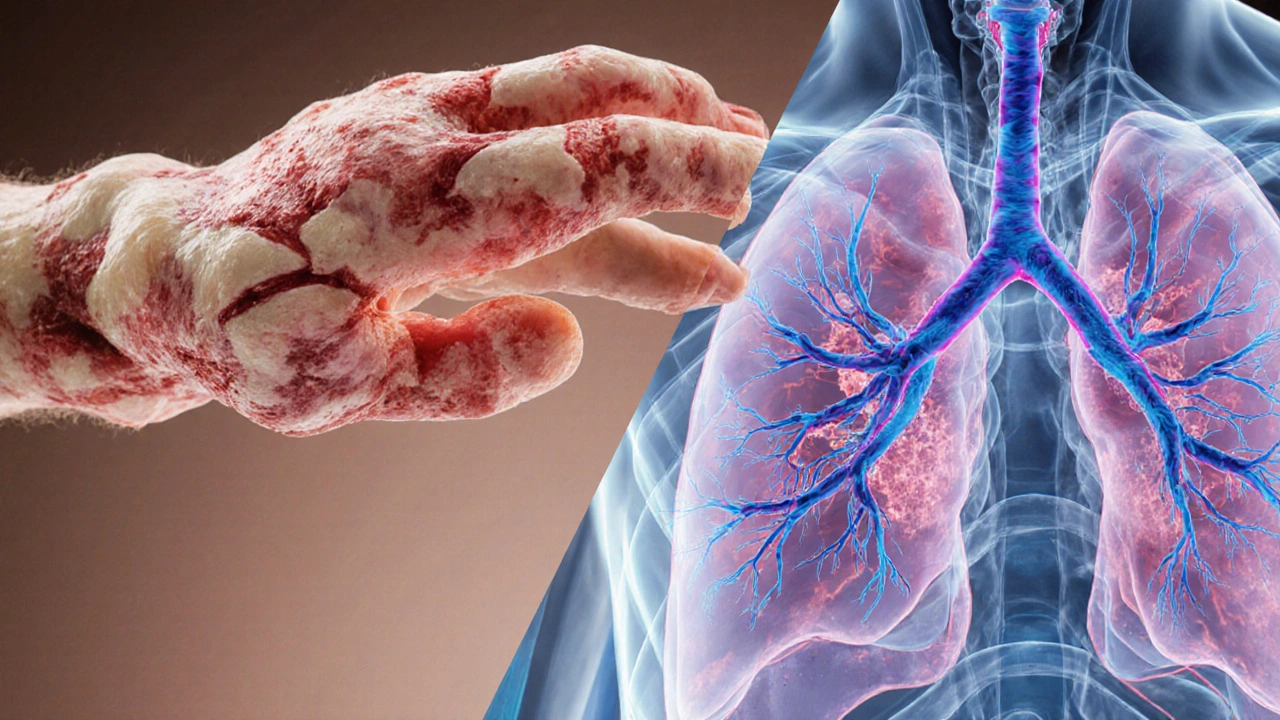RA-PAH Risk Assessment Tool
Patient Information
Fill in the following information to assess the risk of developing PAH in the context of RA.
Assessment Result
Quick Takeaways
- Rheumatoid arthritis (RA) increases the risk of developing pulmonary arterial hypertension (PAH) by up to three‑fold.
- Shared mechanisms include chronic inflammation, endothelial dysfunction, and auto‑antibody‑driven vascular injury.
- Early screening with echocardiography and biomarkers (BNP/NT‑proBNP) can catch PAH before right‑heart failure sets in.
- Therapies that control RA inflammation-especially biologic DMARDs-also lower PAH progression risk.
- Management requires a coordinated approach between rheumatology and pulmonary‑vascular specialists.
What Is Pulmonary Arterial Hypertension?
When clinicians discuss pulmonary arterial hypertension (PAH), they refer to a rare but serious disorder in which the pressure in the lung’s arteries rises sharply. The disease is defined by a mean pulmonary artery pressure≥25mmHg at rest, a pulmonary vascular resistance>3Wood units, and a normal pulmonary capillary wedge pressure. Most patients develop progressive shortness of breath, fatigue, and, without treatment, right‑heart failure.
Key attributes of PAH include:
- Mean pulmonary artery pressure: 25mmHg or higher.
- Right ventricular strain: leads to edema, ascites, and reduced cardiac output.
- Etiology: idiopathic, hereditary, drug‑induced, or associated with systemic diseases such as connective‑tissue disorders.
pulmonary arterial hypertension is often missed early because its symptoms mimic common lung or heart problems.
Rheumatoid Arthritis: A Quick Overview
Rheumatoid arthritis (RA) is a chronic autoimmune disease that primarily attacks synovial joints, causing pain, swelling, and eventual joint deformity. Defined as a autoimmune disease, RA also drives systemic inflammation that can affect blood vessels, lungs, and the heart.
Important RA traits:
- Positive rheumatoid factor (RF) or anti‑CCP antibodies in >70% of patients.
- Elevated C‑reactive protein (CRP) and erythrocyte sedimentation rate (ESR) indicating ongoing inflammation.
- Typical onset between ages 30‑60, more common in women.
Beyond joints, RA can cause interstitial lung disease, pericarditis, and, notably, pulmonary arterial hypertension.

How RA Raises the Risk of PAH
The link between RA and PAH is not a coincidence. Several pathophysiological bridges connect the two conditions:
- Endothelial dysfunction - Chronic systemic inflammation damages the inner lining of pulmonary arteries, reducing nitric oxide production and promoting vasoconstriction.
- Inflammation - Pro‑inflammatory cytokines (IL‑6, TNF‑α) circulate at high levels in RA, triggering smooth‑muscle proliferation within the arterial wall.
- Auto‑antibodies - Anti‑phospholipid and anti‑endothelial cell antibodies observed in RA patients can directly injure pulmonary vessels.
- Right heart failure - As pulmonary pressures climb, the right ventricle works harder, eventually failing if PAH is untreated.
- Genetic predisposition - Certain HLA‑DRB1 alleles increase susceptibility to both severe RA and PAH.
Studies published up to 2024 show that up to 5‑10% of long‑standing RA patients develop PAH, a prevalence markedly higher than in the general population (<1%).
Spotting PAH in People With RA: Diagnosis and Screening
Because early PAH is silent, clinicians rely on a combination of clinical suspicion and simple tests:
- Echocardiography - A non‑invasive ultrasound that estimates pulmonary artery systolic pressure. When the tricuspid regurgitant velocity exceeds 3.4m/s, further work‑up is warranted. (Echocardiography)
- Biomarkers - Elevated brain‑natriuretic peptide (BNP) or NT‑proBNP reflects right‑ventricular strain. (Biomarkers)
- Right‑heart catheterisation - The gold standard that directly measures pulmonary pressures and cardiac output.
Guidelines from the American College of Rheumatology (2023) recommend annual echo screening for RA patients with:
- Long‑standing disease (>10years)
- Positive anti‑CCP antibodies
- Evidence of interstitial lung disease
Early detection improves survival: five‑year mortality drops from 50% to 20% when PAH is identified before right‑heart failure.
Treatment Overlap: Managing Both Conditions
Therapeutic strategies that target RA inflammation often have a positive spill‑over effect on PAH. The main categories include:
- Immunosuppressive therapy - Conventional DMARDs (methotrexate, leflunomide) reduce systemic inflammation, indirectly lowering pulmonary arterial pressure. (Immunosuppressive therapy)
- Biologic agents - TNF‑α inhibitors (etanercept, adalimumab) and IL‑6 blockers (tocilizumab) have shown modest improvement in pulmonary artery pressures in small RA‑PAH cohorts.
- PAH‑specific vasodilators - Phosphodiesterase‑5 inhibitors (sildenafil), endothelin‑receptor antagonists (bosentan), and prostacyclin analogues (epoprostenol) directly lower pulmonary vascular resistance. These are added once PAH is confirmed.
Choosing the right combination requires a multidisciplinary team. For example, a patient on methotrexate who develops early PAH may benefit from adding sildenafil while escalating to a biologic for joint control.

Monitoring and Follow‑up Checklist
Effective long‑term care hinges on regular assessment. Below is a practical checklist for clinicians and patients:
- Baseline echocardiogram at RA diagnosis (if high‑risk features present).
- Quarterly symptom review: dyspnea on exertion, fatigue, peripheral edema.
- Annual BNP/NT‑proBNP measurement.
- Repeat echo every 12‑18months or sooner if symptoms worsen.
- Right‑heart catheterisation if echo suggests PAH progression.
- Adjust RA therapy to maintain CRP<5mg/L; consider biologic switch if inflammation persists.
- Start PAH‑specific drugs when mean pulmonary artery pressure≥25mmHg with clinical signs.
- Monitor drug side‑effects: liver function for endothelin antagonists, vision changes for sildenafil.
Side‑by‑Side Comparison
| Aspect | Pulmonary Arterial Hypertension | Rheumatoid Arthritis |
|---|---|---|
| Primary organ system | Pulmonary vasculature & right heart | Synovial joints (systemic autoimmune) |
| Key symptoms | Exertional dyspnea, fatigue, syncope | Joint pain, swelling, stiffness, fatigue |
| Diagnostic gold standard | Right‑heart catheterisation | RF/anti‑CCP antibodies + imaging |
| First‑line treatment | Vasodilator therapy (PDE‑5i, ERA) | DMARDs (methotrexate) ± biologics |
| Risk of right‑heart failure | High if untreated | Low, but rises with PAH comorbidity |
| Annual prevalence in general pop. | ≈1per1,000 | ≈0.5% (5per1,000) |
What Patients Can Do Today
If you live with RA, consider these proactive steps:
- Ask your rheumatologist about a baseline echo, especially if you’ve had the disease >10years.
- Track any new shortness of breath or swelling and report immediately.
- Maintain tight control of joint inflammation - aim for CRP<5mg/L.
- Stay active; low‑impact aerobic exercise improves both joint flexibility and pulmonary circulation.
- Never stop or change medication without consulting both your rheumatologist and pulmonary‑vascular specialist.
Frequently Asked Questions
How common is PAH in people with rheumatoid arthritis?
Recent cohort studies suggest 5‑10% of long‑standing RA patients develop PAH, compared with less than 1% in the general population.
Can RA medications prevent PAH?
Aggressive control of systemic inflammation with DMARDs and biologics lowers the risk, but it doesn’t guarantee prevention. Regular cardiovascular screening remains essential.
What are the first signs that PAH might be developing?
Unexplained shortness of breath during everyday activities, subtle swelling of ankles, or a feeling of faintness on exertion are early flags that deserve prompt echo evaluation.
Is it safe to combine PAH drugs with biologic DMARDs?
In most cases, yes. Clinical experience shows that sildenafil, bosentan, or prostacyclin analogues can be safely added to biologics, but liver function and blood pressure must be monitored closely.
Will lifestyle changes affect my PAH risk?
Regular low‑impact exercise, smoking cessation, and maintaining a healthy weight reduce overall cardiovascular strain and can improve outcomes for both RA and PAH.


Richa Punyani
October 5, 2025
Early screening for PAH in rheumatoid arthritis patients can truly change outcomes. By scheduling an echocardiogram at diagnosis for high‑risk individuals, clinicians catch pressure elevations before right‑heart strain sets in. Maintaining tight control of CRP and anti‑CCP levels also reduces endothelial injury. A coordinated effort between rheumatology and pulmonary teams ensures that therapy adjustments happen promptly. Remember, patient education about subtle dyspnea is as vital as any lab test.
Bhupendra Darji
October 6, 2025
Collaborative care models have shown measurable benefits for RA‑PAH overlap. When rheumatologists share data with cardiologists, treatment plans become more nuanced and patient‑centred. Simple tools like quarterly symptom checklists keep everyone on the same page. It's encouraging to see guidelines emphasizing multidisciplinary follow‑up. Keep the conversation going across specialties.
Robert Keter
October 7, 2025
When you consider the cascade of inflammatory mediators in rheumatoid arthritis, the picture of pulmonary arterial hypertension begins to emerge with alarming clarity. Interleukin‑6, tumor necrosis factor‑α, and other cytokines do not confine themselves to synovial tissue; they travel systemically, provoking endothelial dysfunction in the delicate vasculature of the lungs. This endothelial injury diminishes nitric oxide synthesis, nudging smooth‑muscle cells toward a proliferative phenotype that narrows the arterial lumen. Anti‑CCP antibodies, often heralds of aggressive joint disease, also possess the uncanny ability to bind to endothelial cells, accelerating vascular inflammation. As the pulmonary vascular resistance climbs, the right ventricle is forced to generate higher pressures, eventually succumbing to maladaptive remodeling. In patients with interstitial lung disease, the hypoxic vasoconstriction adds yet another layer of strain, compounding the hemodynamic burden. Genetic predisposition, especially certain HLA‑DRB1 alleles, further tips the balance toward pathological vascular remodeling. Clinical studies up to 2024 report that up to one in ten long‑standing RA patients develop overt PAH, a prevalence far surpassing the general population. The mortality curve is stark: five‑year survival drops dramatically once right‑heart failure becomes evident. However, early detection through routine echocardiography and biomarker surveillance can blunt this trajectory. Immunosuppressive therapies, particularly biologic DMARDs targeting IL‑6 or TNF‑α, have demonstrated modest reductions in pulmonary artery pressures in small cohort studies. Meanwhile, PAH‑specific vasodilators such as sildenafil or bosentan provide direct hemodynamic relief, buying time for disease‑modifying agents to work. The therapeutic dance therefore demands a multidisciplinary orchestra, with rheumatologists, pulmonologists, and cardiologists each playing a vital role. Patient empowerment is equally crucial; individuals who recognize early dyspnea and edema are more likely to seek timely evaluation. Ultimately, the intertwining of systemic inflammation, auto‑antibody activity, and vascular remodeling underpins the RA‑PAH nexus, making vigilant monitoring and early intervention the keystones of improved survival.
Rory Martin
October 8, 2025
Thus, caution is warranted.
Maddie Wagner
October 8, 2025
Great synthesis of the pathophysiology! Adding to that, recent registry data suggest that routine NT‑proBNP screening every six months can identify subclinical pressure rises even before echocardiographic changes appear. Moreover, integrating a simple six‑minute walk test into clinic visits offers functional context that labs alone miss. For patients already on a TNF‑α inhibitor, a switch to an IL‑6 blocker has sometimes led to measurable drops in pulmonary pressures, likely due to stronger cytokine suppression. Remember to counsel patients on low‑impact aerobic exercise, which can improve right‑ventricular reserve without overtaxing inflamed joints. A multidisciplinary clinic setting, where rheumatology and pulmonary vascular specialists see the patient together, reduces appointment lag and improves adherence to both immunosuppressive and PAH‑targeted regimens.
Boston Farm to School
October 9, 2025
Interesting how cultural differences affect disease perception – in some regions patients report shortness of breath as just tired which can delay PAH diagnosis. It makes me wonder if community education programs could bridge that gap ☺
Emily Collier
October 10, 2025
While community outreach is undoubtedly valuable, we must also acknowledge that clinical vigilance cannot be outsourced entirely to public awareness campaigns. Robust screening protocols within rheumatology practices remain the cornerstone of early PAH identification, and relying too heavily on patient‑initiated reporting may inadvertently widen existing disparities.
Catherine Zeigler
October 11, 2025
Staying proactive in managing both RA and PAH can feel overwhelming, but breaking the plan into manageable steps makes a huge difference. Start by setting a quarterly reminder for echo appointments and sync it with your joint medication review. Next, keep a simple symptom diary-note any new breathlessness, swelling, or fatigue, even if they seem minor. Pair this with regular blood work to track CRP and anti‑CCP trends, giving your doctor concrete data to adjust therapy. Celebrate small victories, like a week with stable pressure readings or a joint flare that responds quickly to treatment. Remember, consistency beats intensity when it comes to chronic disease management.
henry leathem
October 12, 2025
Frankly, the so‑called “manageable steps” approach is a veneer for inadequate intensive monitoring. In high‑risk RA cohorts, semi‑annual right‑heart catheterization should be the gold standard, not a leisurely echo schedule. Without such rigor, we risk under‑detecting hemodynamic shifts that only manifest subtly on imaging.
Kristen Holcomb
October 14, 2025
I've seen patients who ignore mild dyspnea until it's too late, which underscores the need for assertive patient education. When we ask patients to track their breathlessness on a simple scale, we empower them to flag changes early. This proactive stance can shave months off the time to diagnosis, improving outcomes significantly.
Tina Johnson
October 15, 2025
While patient‑reported outcomes are valuable, they must be corroborated by objective metrics such as serial BNP levels and pulmonary function testing. Relying solely on subjective scales may introduce bias and under‑estimate disease progression.
Sharon Cohen
October 16, 2025
Some clinicians argue that the link between RA and PAH is overstated, suggesting that observed cases may stem from confounding comorbidities rather than a direct pathogenic bridge.
Rebecca Mikell
October 17, 2025
While confounding factors exist, multiple longitudinal studies have consistently demonstrated a statistically significant increase in PAH incidence among RA patients, even after adjusting for smoking and age.
Jaime Torres
October 18, 2025
Data aside the guidelines need more real‑world validation.